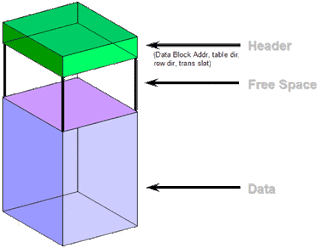
The Database Block (dbblock) has the following structure:
Header - The header contains general information about the data; i.e. block address and type of segments (table, index, etc.). The header also contains information about the table and the actual row (address) that holds the data.
Free Space - Space allocated for future update/insert operations. Generally affected by the values of PCTFREE and PCTUSED parameters.
Data - Actual row data.While creating/altering any table/index, Oracle used two storage parameters for space control.
PCTFREE: The percentage of space reserved for future update of existing data.
PCTUSED: The percentage of minimum space used for insertion of new row data. This value determines when the block gets back into Free List table.